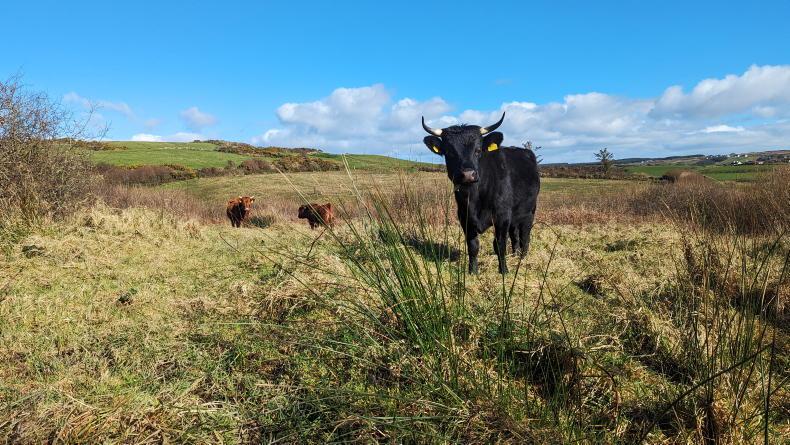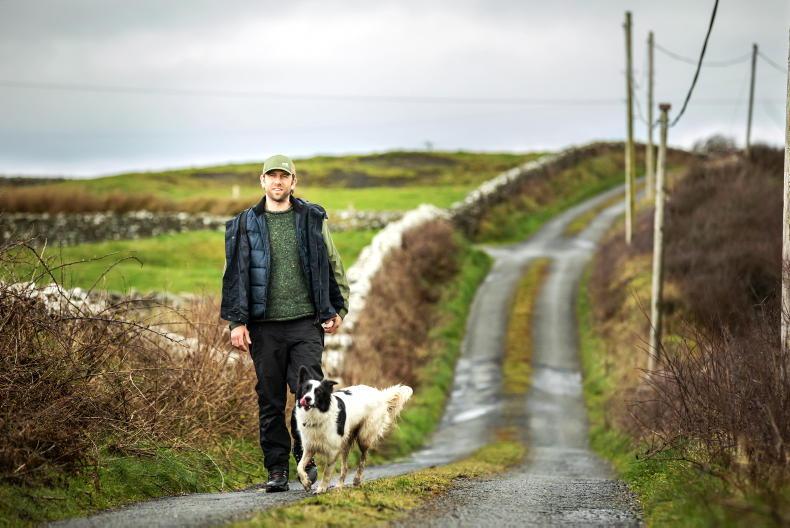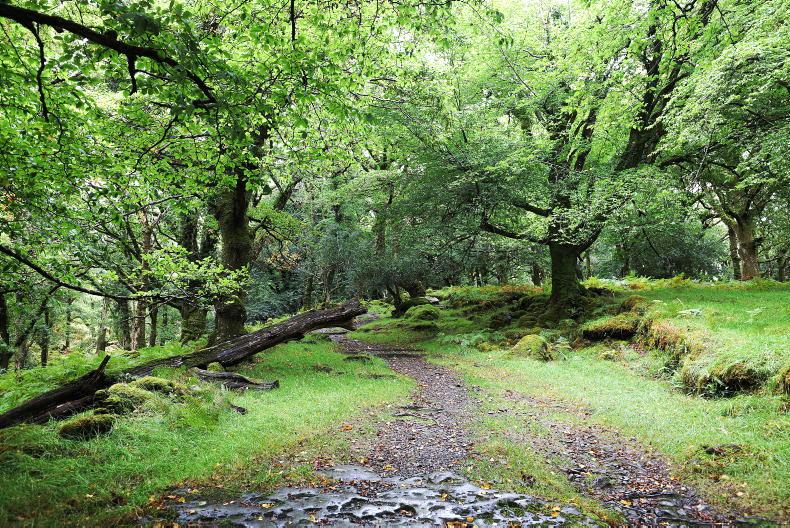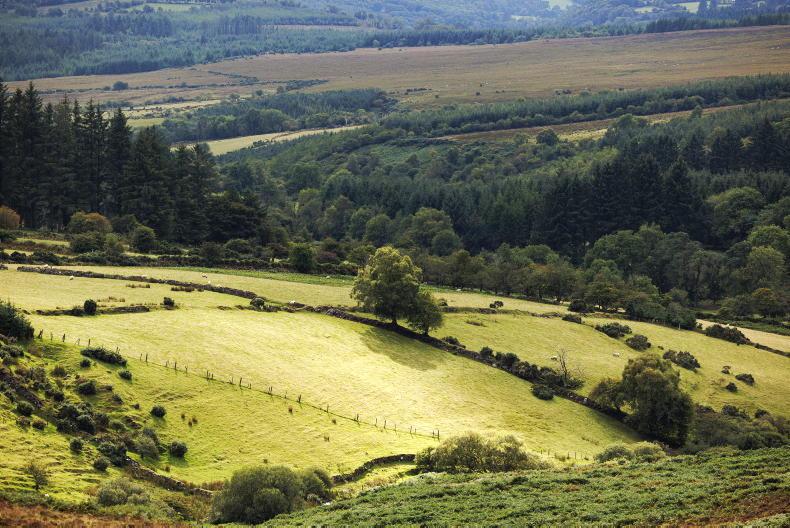I’m a big fan of demonstration farms. They allow theoretical approaches to be tested in real world situations, and critically give farmers an opportunity to see best practice at farm level. I’ve been to many in recent years and I’m consistently impressed by their approach.
There are a handful currently working on suckler farming or systems relevant to suckler farmers.
Dairy beef, finishing times and profitability are all being trialled, each one pushing the limits of animal genetics, feeding regimes and grassland management.
The issue is that the systems they are developing aren’t relevant to many suckler farms here in the west. In fact, I believe much of what they are focusing on would spell bad news for these farms and the nature they host.
The reality is there is limited opportunity to implement their findings due to farm scale, land quality, investment requirement and time limitations.
Amazing suckler farms
The undemanding nature of the suckler cow lends itself well to high nature value farming, particularly species-rich grassland habitats and upland habitats.
Along the west coast and into the midlands, these farms form the last line of defence for our most endangered species. On Inishbofin (Inis Bó Finne – Island of the White Cow), they sustain the corncrake.
In the Slieve Aughties, Shorthorns and Galloways graze the uplands where the hen harrier breeds, and in the Burren, continental breeds, suited to the dry ground, graze karst meadows of gentians and orchid.
One of the best parts of my job is the opportunity to visit these places. I was on a farm in west Clare recently and was blown away by its biodiversity.
Tall willow hedges, field margins of meadowsweet and purple loosestrife, meadows of orchid and yellow rattle.
On a steep embankment an old sessile oak woodland led up to an elevated piece of blanket bog; truly special.
These are small farms, often only 50ac to 100ac. Many have avoided the restructuring and improvement seen in other parts of the country. Their owners love farming but often have limited time and money to put into the farm.
Like the suckler cow itself, this socioeconomic reality lends itself to a gentler type of farming.
While they may not always be exemplars of low-emission farming, the public goods they are producing (or could produce) more than justify their existence.
In my view, these farms have no business reseeding grasslands, driving dry matter production, or feeding excessive rations, which tends to be where ‘progressive’ farming is going.
Unintended but damaging message
Demonstration farms tend to implement the most recent research. These days, this is typically focused on efficiency and emissions. The high-profile nature of these farms secures lots of press coverage, and this informs the narrative around what ‘good’ farming is (or isn’t).
Those engaged in low-intensity nature-friendly farming can come to be viewed as old-fashioned or somehow not serious. This is damaging.
When I speak to these high nature value farmers, they often downplay their farming activities: “Ah sure look, I only keep a few cows.” Far from being ‘at nothing’, these men and women are critical custodians of Ireland’s biodiversity.

In pursuit of emission reduction and production efficiency we must be careful not to lose what already exists. \ Ray Ó Foghlú
Without alternative farm models to aspire to, they are consistently nudged into implementing ‘progressive’ measures.
Due to the farm constraints outlined above, these measures are often only partially adopted, leading to scenarios which are neither profitable, nor productive nor nature-friendly – the worst of all worlds.
Instead of viewing these farms as inferior, we should be elevating and improving their approach in the same way we do with high-efficiency farming.
These farmers don’t expect too much from their farms. Most work off-farm. For this reason, there is scope to trial initiatives that would impact viability in other sectors.
It’s not hard for me to imagine a farm with ancient woodland expansion, peatland rewetting and species-rich grassland restoration occurring side by side.
They could even trial local species introduction, as happened with the curlew in Kerry recently.

Biodiversity is typically a secondary consideration on demonstration farms. We need one where nature is the primary focus. \ Ray Ó Foghlú
Right now, we have no demonstration farm that is focused on nature. In fact, the important work of elevating this approach to farming is left to precariously funded initiatives such as Farming for Nature, or to individual farmers.
In a world where biodiversity loss is quickly emerging as an issue as significant as climate change, this represents a huge opportunity lost. Just as it has done with carbon, the market will begin to demand nature restoration.
Suckler farms are uniquely positioned to meet this need, but they require a model to aspire to, a model which is suited to the changing times we live in.
We are still at the very early stages of the ecosystem services market, so it’s unlikely that a commercial operator would get behind such a demo farm. Therefore, it falls to the State.
A demonstration high nature value farm could position the sector to benefit from novel future markets for products they excel at producing.
I had a good chat with Minister McConalogue at the Clonmany Agricultural Show last week.
Growing up on a small farm himself, he understands the challenges faced by these kinds of farms but, also, their potential.
Imagine what a great legacy he could leave behind as Minister for Agriculture by creating the country’s first ever high nature value demonstration farm.
Suckler cows lend themselves to high nature value farming, such as upland and species-rich habitats.
Suckler farms in the west are the last line of defence for some endangered species. It’s time for a demonstration farm geared towards high nature value farming.
I’m a big fan of demonstration farms. They allow theoretical approaches to be tested in real world situations, and critically give farmers an opportunity to see best practice at farm level. I’ve been to many in recent years and I’m consistently impressed by their approach.
There are a handful currently working on suckler farming or systems relevant to suckler farmers.
Dairy beef, finishing times and profitability are all being trialled, each one pushing the limits of animal genetics, feeding regimes and grassland management.
The issue is that the systems they are developing aren’t relevant to many suckler farms here in the west. In fact, I believe much of what they are focusing on would spell bad news for these farms and the nature they host.
The reality is there is limited opportunity to implement their findings due to farm scale, land quality, investment requirement and time limitations.
Amazing suckler farms
The undemanding nature of the suckler cow lends itself well to high nature value farming, particularly species-rich grassland habitats and upland habitats.
Along the west coast and into the midlands, these farms form the last line of defence for our most endangered species. On Inishbofin (Inis Bó Finne – Island of the White Cow), they sustain the corncrake.
In the Slieve Aughties, Shorthorns and Galloways graze the uplands where the hen harrier breeds, and in the Burren, continental breeds, suited to the dry ground, graze karst meadows of gentians and orchid.
One of the best parts of my job is the opportunity to visit these places. I was on a farm in west Clare recently and was blown away by its biodiversity.
Tall willow hedges, field margins of meadowsweet and purple loosestrife, meadows of orchid and yellow rattle.
On a steep embankment an old sessile oak woodland led up to an elevated piece of blanket bog; truly special.
These are small farms, often only 50ac to 100ac. Many have avoided the restructuring and improvement seen in other parts of the country. Their owners love farming but often have limited time and money to put into the farm.
Like the suckler cow itself, this socioeconomic reality lends itself to a gentler type of farming.
While they may not always be exemplars of low-emission farming, the public goods they are producing (or could produce) more than justify their existence.
In my view, these farms have no business reseeding grasslands, driving dry matter production, or feeding excessive rations, which tends to be where ‘progressive’ farming is going.
Unintended but damaging message
Demonstration farms tend to implement the most recent research. These days, this is typically focused on efficiency and emissions. The high-profile nature of these farms secures lots of press coverage, and this informs the narrative around what ‘good’ farming is (or isn’t).
Those engaged in low-intensity nature-friendly farming can come to be viewed as old-fashioned or somehow not serious. This is damaging.
When I speak to these high nature value farmers, they often downplay their farming activities: “Ah sure look, I only keep a few cows.” Far from being ‘at nothing’, these men and women are critical custodians of Ireland’s biodiversity.

In pursuit of emission reduction and production efficiency we must be careful not to lose what already exists. \ Ray Ó Foghlú
Without alternative farm models to aspire to, they are consistently nudged into implementing ‘progressive’ measures.
Due to the farm constraints outlined above, these measures are often only partially adopted, leading to scenarios which are neither profitable, nor productive nor nature-friendly – the worst of all worlds.
Instead of viewing these farms as inferior, we should be elevating and improving their approach in the same way we do with high-efficiency farming.
These farmers don’t expect too much from their farms. Most work off-farm. For this reason, there is scope to trial initiatives that would impact viability in other sectors.
It’s not hard for me to imagine a farm with ancient woodland expansion, peatland rewetting and species-rich grassland restoration occurring side by side.
They could even trial local species introduction, as happened with the curlew in Kerry recently.

Biodiversity is typically a secondary consideration on demonstration farms. We need one where nature is the primary focus. \ Ray Ó Foghlú
Right now, we have no demonstration farm that is focused on nature. In fact, the important work of elevating this approach to farming is left to precariously funded initiatives such as Farming for Nature, or to individual farmers.
In a world where biodiversity loss is quickly emerging as an issue as significant as climate change, this represents a huge opportunity lost. Just as it has done with carbon, the market will begin to demand nature restoration.
Suckler farms are uniquely positioned to meet this need, but they require a model to aspire to, a model which is suited to the changing times we live in.
We are still at the very early stages of the ecosystem services market, so it’s unlikely that a commercial operator would get behind such a demo farm. Therefore, it falls to the State.
A demonstration high nature value farm could position the sector to benefit from novel future markets for products they excel at producing.
I had a good chat with Minister McConalogue at the Clonmany Agricultural Show last week.
Growing up on a small farm himself, he understands the challenges faced by these kinds of farms but, also, their potential.
Imagine what a great legacy he could leave behind as Minister for Agriculture by creating the country’s first ever high nature value demonstration farm.
Suckler cows lend themselves to high nature value farming, such as upland and species-rich habitats.
Suckler farms in the west are the last line of defence for some endangered species. It’s time for a demonstration farm geared towards high nature value farming.












SHARING OPTIONS